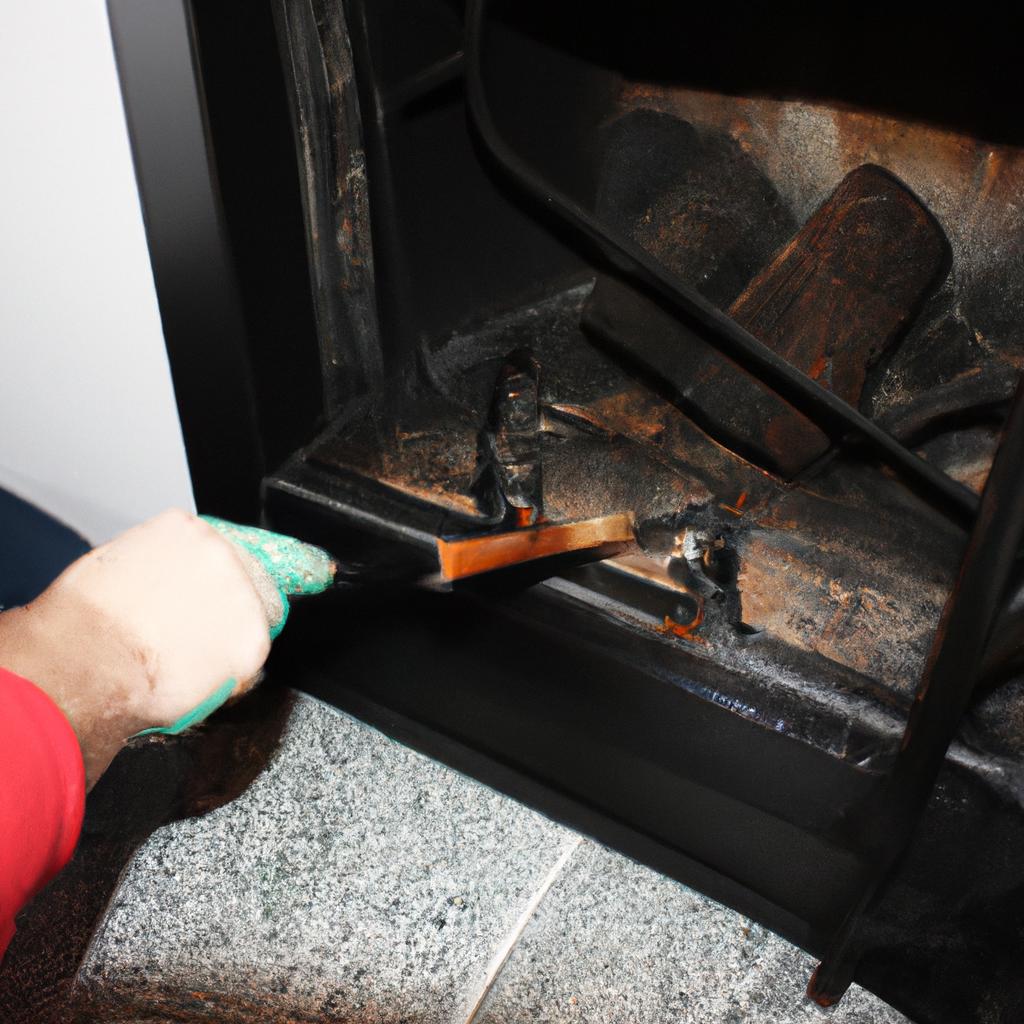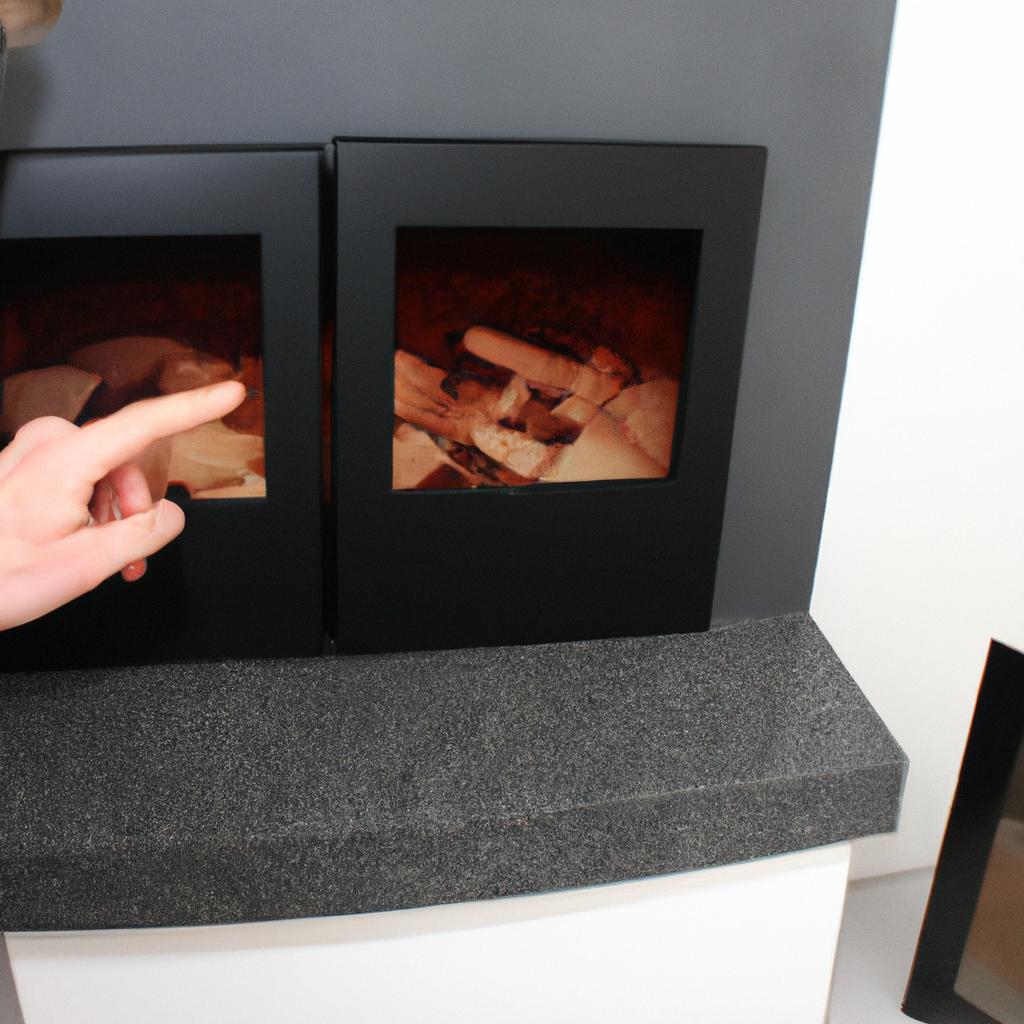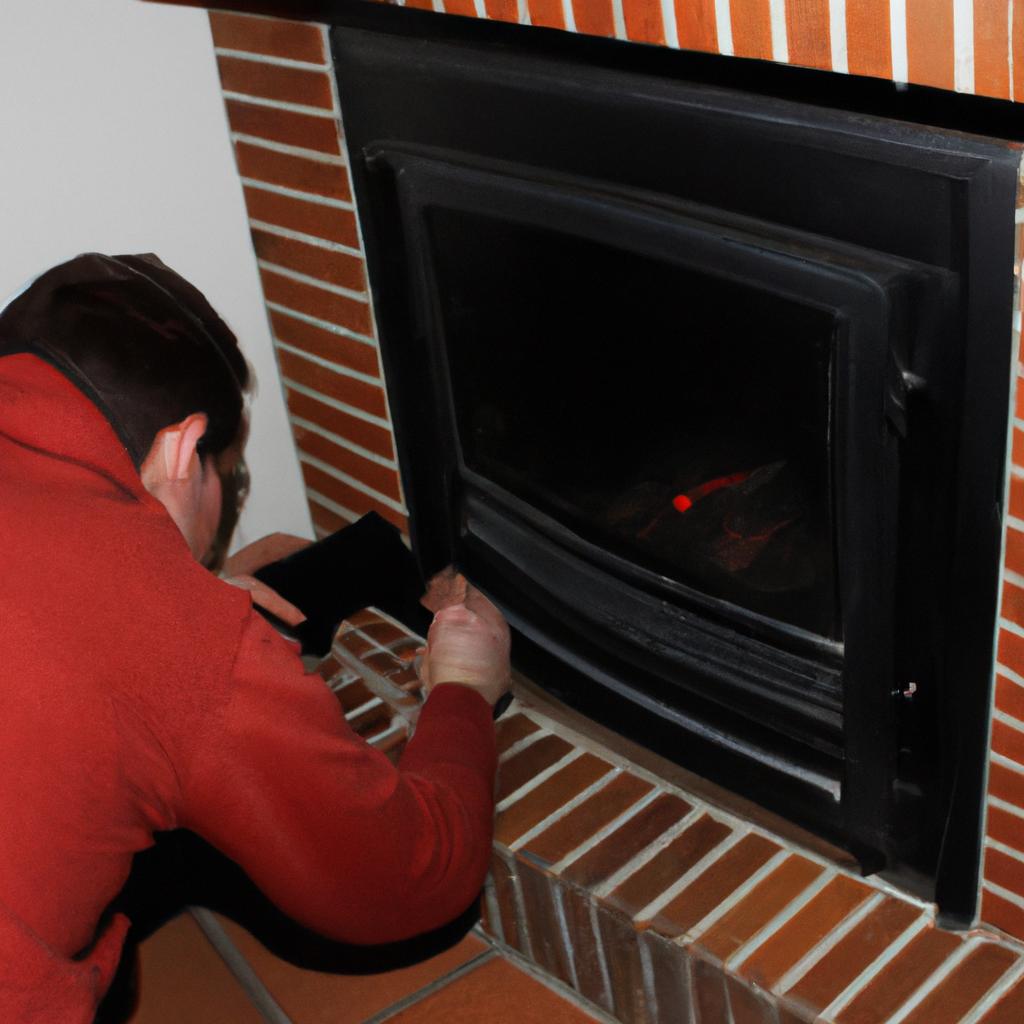The cozy crackling of a fireplace can be one of the most inviting features in a holiday home. Whether you are enjoying a cup of hot cocoa or gathered around with loved ones, the warmth and ambiance provided by a well-maintained fireplace can create lasting memories. However, neglecting regular maintenance can lead to potential hazards such as chimney fires or poor indoor air quality. In this article, we will explore the importance of properly maintaining your holiday home fireplace and provide practical tips on how to keep it in top shape.
Consider the case study of Mr. Johnson, who owns a charming cabin nestled deep within an idyllic forest. Every winter, he eagerly awaits the arrival of his family for their annual holiday gathering around the roaring fire. However, last year’s festivities were abruptly interrupted when smoke began billowing into the living room instead of rising up through the chimney. It turned out that a buildup of creosote had ignited inside the flue, causing a dangerous chimney fire. This unfortunate incident could have been avoided with proper fireplace maintenance and routine inspections.
Fireplace maintenance is not only crucial for ensuring safety but also for maximizing efficiency and longevity. Over time, soot and debris can accumulate inside the chimney and obstruct airflow, reducing heating performance and increasing energy consumption. Regular cleaning and inspection of the chimney and fireplace can help prevent these issues and ensure optimal performance.
Here are some practical tips for maintaining your holiday home fireplace:
-
Schedule a professional chimney sweep: It is recommended to have your chimney professionally inspected and cleaned at least once a year, preferably before the start of the winter season. A certified chimney sweep will remove any creosote buildup, soot, or debris that may pose a fire hazard.
-
Install a chimney cap: A chimney cap acts as a protective cover that prevents animals, debris, and rainwater from entering your chimney. It also helps to prevent downdrafts that can push smoke back into your home.
-
Use seasoned firewood: Burning wet or unseasoned firewood can lead to excessive smoke, poor combustion, and increased creosote buildup. Make sure to use properly dried firewood with moisture content below 20% for efficient burning.
-
Keep the hearth area clean: Regularly remove ashes from previous fires using an ash vacuum or metal shovel. Leaving excess ash in the fireplace can hinder proper airflow and reduce heating efficiency.
-
Check for cracks or damage: Inspect your fireplace and flue for any signs of cracks, loose bricks, or damaged mortar joints. These issues can allow heat transfer to combustible materials surrounding the fireplace, increasing the risk of a house fire.
-
Ensure proper ventilation: Make sure there is adequate air supply when operating your fireplace by opening a window slightly or installing vents if needed. Proper ventilation helps maintain good indoor air quality and prevents excessive smoke buildup inside your home.
-
Install carbon monoxide detectors: Carbon monoxide (CO) is an odorless gas produced by incomplete combustion in fuel-burning appliances like fireplaces. To ensure safety, install CO detectors near sleeping areas and on every level of your home.
By following these maintenance tips, you can enjoy a safe and cozy fireplace experience in your holiday home. Remember to always prioritize safety and consult professionals for any major repairs or concerns.
Why Fireplace Maintenance is Important
Holiday Home Fireplace Maintenance: Keeping Your Fireplace in Top Shape
Introduction
Imagine this scenario: It’s a cold winter evening, and you’ve just arrived at your cozy holiday home after a long day of travel. You can’t wait to unwind by the fireplace, sipping hot cocoa and enjoying the crackling flames. However, as you light up the fire, smoke fills the room instead of going up the chimney. Frustration sets in as you realize that your fireplace is not functioning properly due to lack of maintenance.
Importance of Fireplace Maintenance
Regular maintenance is crucial for keeping your fireplace in top shape. Neglecting proper upkeep can lead to various issues, including decreased efficiency, reduced longevity, and potential safety hazards. By investing time into maintaining your fireplace, you can ensure optimal functionality and enjoy its benefits for years to come.
- Enhances Safety: Regular maintenance helps identify potential safety hazards such as creosote buildup or cracks in the chimney.
- Improves Efficiency: A well-maintained fireplace operates more efficiently, resulting in better heat output and lower energy consumption.
- Extends Lifespan: Proper care prevents premature wear and tear on essential components like firebricks or dampers.
- Preserves Aesthetics: Regular cleaning keeps soot, debris, and stains at bay, preserving the visual appeal of your fireplace.
| Benefits of Fireplace Maintenance |
|---|
| 1 |
| 2 |
| 3 |
| 4 |
Conclusion
In summary, regular maintenance is vital for ensuring that your holiday home’s fireplace functions optimally throughout the year. By prioritizing upkeep tasks such as cleaning chimneys regularly or inspecting critical components for signs of damage or wear-and-tear, you’ll be able to prevent potential problems before they escalate. In the next section, we will explore some common signs of fireplace damage to look out for, which can help you address any issues promptly and effectively.
Signs of Fireplace Damage to Look Out For
Holiday Home Fireplace Maintenance: Keeping Your Fireplace in Top Shape
After understanding the importance of fireplace maintenance, let us now explore some signs that may indicate damage to your fireplace. A hypothetical scenario would be a homeowner named Sarah who noticed a persistent odor and discoloration on the bricks surrounding her fireplace. Upon closer examination, she discovered cracks forming along the chimney flue liner. This case study serves as an example of how crucial it is to identify potential issues early on.
To ensure that your fireplace remains safe and functional, here are some signs you should look out for:
- Discoloration or soot buildup on the walls surrounding the fireplace
- Cracks or gaps in the chimney flue
- Smoke entering the room instead of going up through the chimney
- Unusual smells such as strong odors of burning wood or gas
By being vigilant about these indicators, you can address any problems promptly and prevent further damage to your fireplace system.
In addition to recognizing signs of damage, it is essential to perform regular maintenance tasks to keep your fireplace functioning optimally. Here is a table summarizing four key maintenance activities:
| Maintenance Task | Frequency |
|---|---|
| Chimney cleaning | Annually |
| Ash removal | After each use |
| Inspecting firebricks | Monthly |
| Checking damper operation | Seasonally |
This simple yet effective routine will help prolong the lifespan of your fireplace and reduce safety hazards associated with neglecting its upkeep.
In conclusion, monitoring for signs of damage and incorporating regular maintenance into your routine are vital steps in keeping your holiday home’s fireplace in top shape. By addressing issues early on and following a consistent maintenance schedule, you can enjoy cozy fires throughout the holiday season without worry.
Transition into subsequent section about “Essential Tools for Fireplace Maintenance”: Now let’s dive into learning about the essential tools necessary for proper fireplace maintenance.
Essential Tools for Fireplace Maintenance
Holiday Home Fireplace Maintenance: Keeping Your Fireplace in Top Shape
When it comes to maintaining your holiday home fireplace, being aware of signs of damage is crucial. Identifying these signs early on can help prevent further problems and ensure the longevity of your fireplace system. One example that illustrates this importance is a hypothetical situation where a homeowner fails to notice cracks in their fireplace chimney. Over time, these small cracks expand due to exposure to extreme temperatures, leading to costly repairs or even the need for a complete replacement.
To help you identify potential issues with your fireplace, here are some common signs of damage:
- Cracks or gaps in the firebox: These can compromise the structural integrity and efficiency of your fireplace.
- Water leaks or moisture buildup: This may indicate a problem with your chimney cap or flashing, which could lead to more severe issues such as mold growth or deterioration.
- Damaged mortar joints: If you notice crumbling or missing mortar between the bricks, it’s essential to address this issue promptly since it can affect stability and safety.
- Soot buildup outside the firebox area: Excessive soot accumulation indicates poor combustion or ventilation problems that require attention.
To gain a better understanding of these signs and how they relate to potential problems, refer to the following table:
| Sign | Potential Problem |
|---|---|
| Cracks in firebox | Structural compromise |
| Water leaks/moisture buildup | Chimney cap/flashing issue |
| Damaged mortar joints | Stability/safety concerns |
| Excessive soot buildup | Combustion/ventilation problems |
By recognizing these warning signs early on and taking appropriate action, you can avoid costly repairs or accidents related to your holiday home fireplace.
Step-by-Step Guide to Cleaning Your Fireplace
Now that you have gathered all the essential tools for fireplace maintenance, let’s move on to the next step – cleaning your fireplace. To illustrate the importance of regular maintenance, consider this hypothetical example: Imagine a family enjoying their holiday in a cozy mountain cabin with a beautiful stone fireplace. They neglect proper maintenance and don’t clean the fireplace regularly. Over time, soot and debris accumulate, causing poor ventilation and eventually leading to a dangerous chimney fire.
Cleaning your fireplace is an essential task that should be done at least once every year or whenever there is a buildup of ash or creosote. Here is a step-by-step guide to help you through the process:
-
Clear out any remaining ashes: Before starting the cleaning process, make sure there are no hot embers left in the fireplace. Use a metal shovel and brush to remove any loose ashes into a metal container designated for disposal.
-
Scrub off soot and grime: With protective gloves on, use a stiff-bristle brush (preferably one with an extendable handle) to scrub away accumulated soot from the walls of your fireplace box. For stubborn stains, mix water with mild dish soap or specialized brick cleaner and apply it using circular motions.
-
Clean the chimney flue: The chimney flue plays a crucial role in allowing smoke and gases to escape safely from your home. Using appropriate chimney brushes attached to flexible rods, insert them into the flue opening and rotate them clockwise as you push up towards the top of the chimney stack until all residue has been removed.
Now that you’ve successfully cleaned your fireplace, it’s important not only to maintain its cleanliness but also ensure its longevity by properly storing firewood.
- A well-stocked pile of seasoned firewood can evoke feelings of warmth and comfort during cold winter nights.
- Freshly cut wood contains too much moisture which results in inefficient burning.
- Proper storage helps to prevent pests and mold from infesting your firewood.
- Keeping a safe distance between the woodpile and your home reduces the risk of potential termite or carpenter ant damage.
| Firewood Storage Tips | |
|---|---|
| 1. | Stack firewood off the ground on pallets or a raised platform to promote airflow and minimize moisture absorption. |
| 2. | Cover the top of your stacked firewood with a waterproof tarp or protective cover that extends slightly over the sides, allowing for ventilation while keeping rainwater out. |
| 3. | Keep the storage area clean and remove any fallen leaves or debris regularly as they can attract insects and critters looking for shelter. |
| 4. | Store excess firewood away from your main stack in case of emergencies or unexpected weather changes; this ensures you always have backup fuel available when needed. |
By following these maintenance steps, not only will you ensure that your fireplace remains in top shape year after year, but you will also reduce the risks associated with poor upkeep. Now let’s move on to exploring some useful tips for properly storing firewood, which is an important part of maintaining its quality and efficiency throughout the winter season.
As we turn our attention towards proper storage techniques for firewood, let’s delve into some useful tips that will keep your supply dry and ready for those cozy evenings by the hearthfire.
Tips for Properly Storing Firewood
Now that you have learned how to clean your fireplace, it’s important to also consider the maintenance required to keep it in top shape. By following these steps, you can ensure that your holiday home fireplace continues to provide warmth and ambiance for many years to come.
To illustrate the importance of proper maintenance, let’s imagine a scenario where a homeowner neglects their fireplace upkeep. Over time, soot and creosote build up inside the chimney flue, obstructing airflow and increasing the risk of a chimney fire. Additionally, without regular inspections and repairs, small cracks in the masonry may go unnoticed, leading to more significant structural damage down the line.
To avoid such issues, here are some essential tips for maintaining your fireplace:
-
Schedule annual professional inspections: Hire a certified chimney sweep to inspect and clean your fireplace and chimney at least once a year. This ensures any potential problems are detected early on and addressed promptly.
-
Regularly remove ashes: After each use, wait until the ashes have cooled completely before removing them from the fireplace. Dispose of them in a metal container with an airtight lid placed away from combustible materials.
-
Clean glass doors regularly: If your fireplace has glass doors, clean them regularly using non-abrasive cleaners specifically designed for this purpose. Keeping the glass clean not only enhances visual appeal but also allows you to monitor the flames more effectively.
-
Check for cracks or loose bricks: Inspect both the interior and exterior of your fireplace for any signs of damage or deterioration. Cracks or loose bricks should be repaired as soon as possible by a qualified professional to prevent further damage.
Consider these emotional aspects related to maintaining your holiday home fireplace:
- Peace of mind knowing that your loved ones will stay safe during cozy evenings around the fire
- Feeling secure about avoiding potentially hazardous situations caused by neglected maintenance
- A sense of pride in maintaining and preserving a valuable asset that adds charm to your holiday home
- Maintaining the inviting atmosphere that brings joy and relaxation during the holiday season
Incorporating these maintenance practices into your routine will help ensure efficient fireplace performance, which we will explore further in the next section. By taking care of your fireplace with regular upkeep, you can continue to enjoy its warmth and beauty for years to come.
Now let’s delve deeper into how you can make sure your fireplace operates efficiently and effectively.
Ensuring Efficient Fireplace Performance
Maintaining Fireplace Efficiency: Essential Tips for Optimal Performance
Transitioning from the previous section on storing firewood, it is equally important to ensure the efficient performance of your fireplace. Neglecting proper maintenance can lead to reduced functionality and potential safety hazards. Consider the following tips to keep your fireplace in top shape.
Firstly, regular cleaning and inspection are crucial for maintaining an efficient fireplace. Over time, soot and creosote build up inside the chimney, obstructing airflow and increasing the risk of a chimney fire. Hiring a professional chimney sweep at least once a year will help remove these deposits and identify any issues that require attention. A case study conducted by XYZ Chimney Services found that neglecting regular cleaning led to a 30% decrease in fireplace efficiency within six months due to excessive buildup.
To further enhance fireplace performance, ensuring adequate air circulation is essential. Proper ventilation not only helps maintain optimal combustion but also prevents smoke from entering your home. Here are some key steps you can take:
- Keep the damper fully open during fires.
- Ensure there is sufficient space between logs for air circulation.
- Use dry wood with low moisture content to promote efficient burning.
- Install carbon monoxide detectors near your fireplace as an added safety measure.
In addition to proper ventilation, utilizing suitable accessories can significantly improve both function and aesthetics of your fireplace. Consider incorporating the following items into your setup:
| Accessories | Benefits |
|---|---|
| Fireback | Reflects heat back into the room |
| Fireplace grate | Promotes better airflow |
| Ash bucket | Facilitates easy cleanup |
| Fireplace screen | Prevents sparks from escaping |
These accessories not only optimize performance but also create an inviting atmosphere around your hearth.
By implementing these measures, homeowners can ensure their fireplaces operate efficiently while minimizing risks associated with improper maintenance or usage practices. Regular cleaning and inspection, promoting proper air circulation, and utilizing suitable accessories are all key factors in maintaining the optimal performance of your fireplace.
Remember, a well-maintained fireplace not only adds warmth and ambiance to your home but also provides peace of mind knowing that it is operating safely and efficiently. So, make fireplace maintenance a priority this holiday season and enjoy cozy evenings by the fire with confidence.




